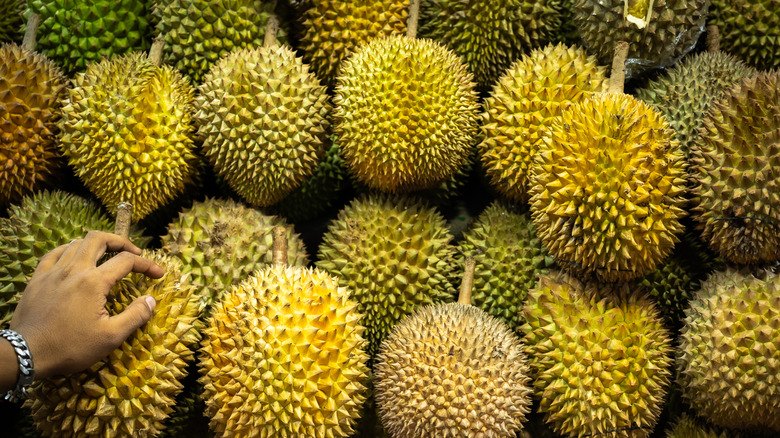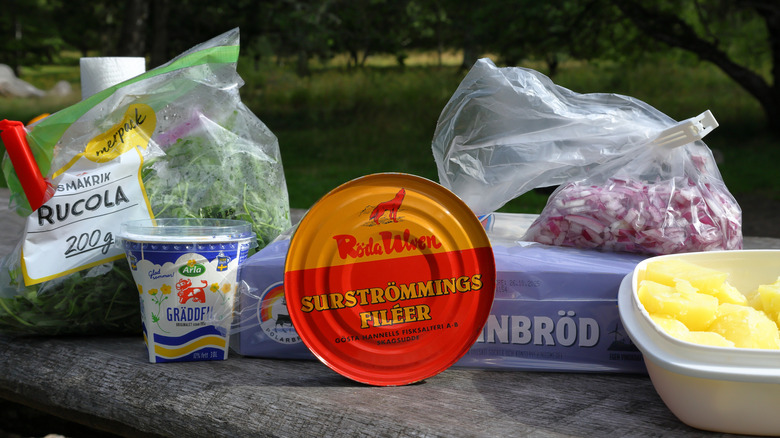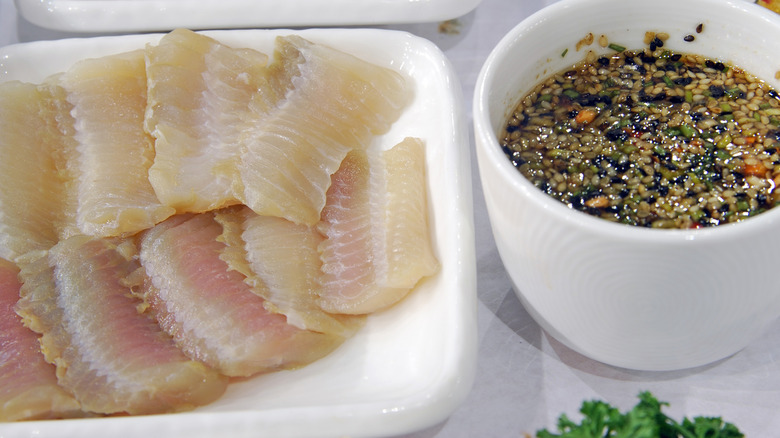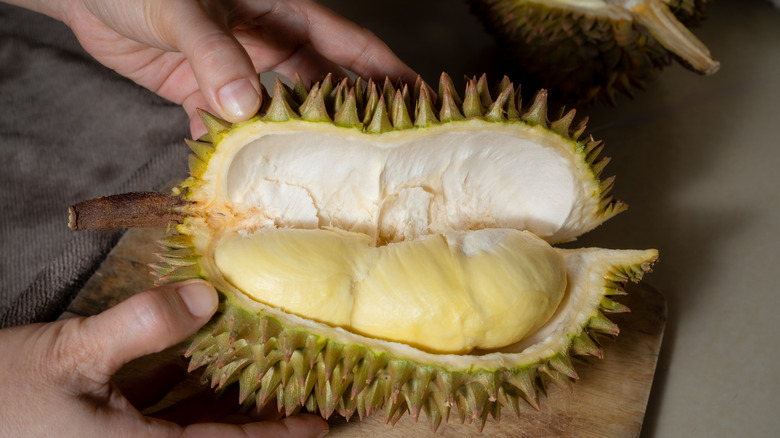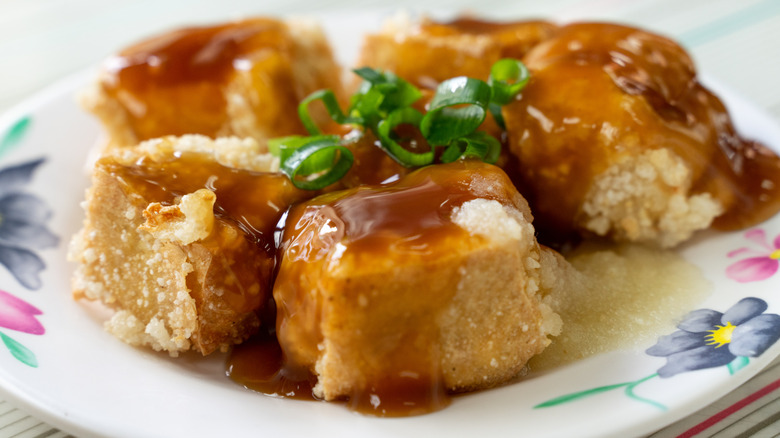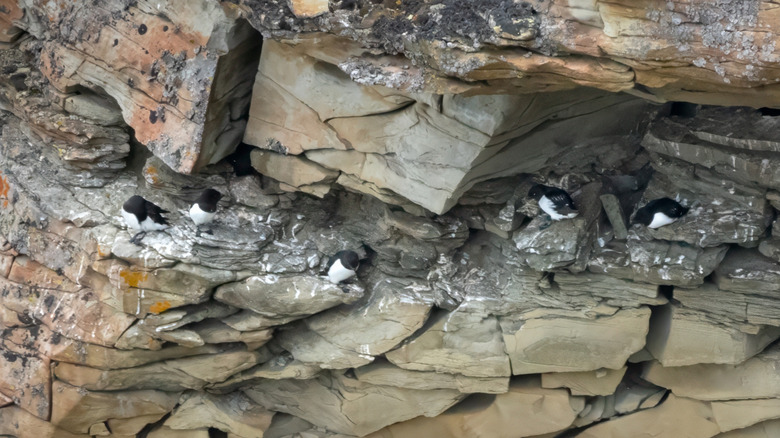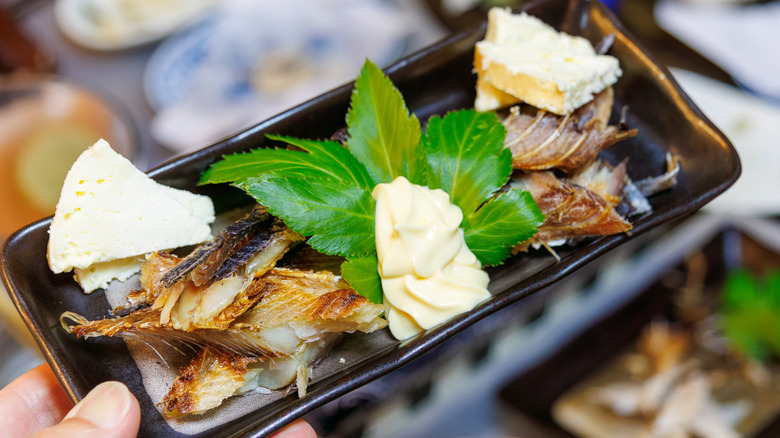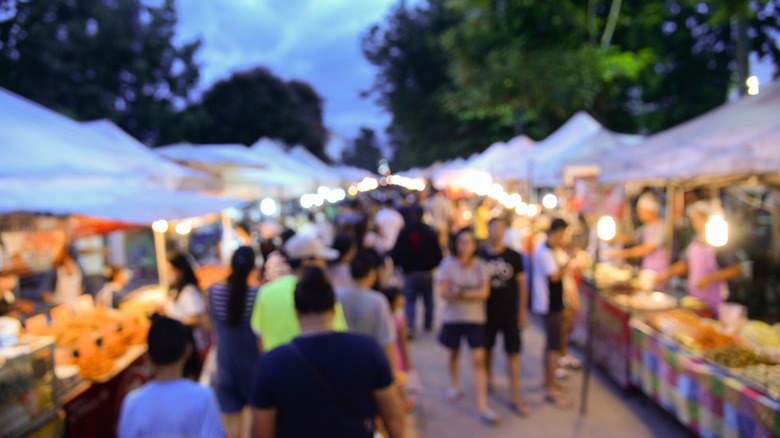These Are The Stinkiest Foods On Earth — Would You Dare To Try Them?
Eating is a multi-sensory experience. Just a single whiff of a particular food can immediately transport you back to a memorable place, whether it's the smell of durian in a Bangkok street market or the pungent ammonia odor of fermented fish in Sweden. Smell has a direct link with memory and emotion. Your nose isn't just detecting molecules, it's cataloging memories. That's why "stinky" foods can become iconic despite their pungency. Those memories can linger on your tongue and in your mind. In some cases, those memories may be tied to joyous cultural experiences in your previous travels.
A sense of disgust towards a particular scent originally protected people from ingesting poisonous substances. However, it's now given rise to something else: pungent flavors people know and love. These flavors have various origins, including fermentation techniques, the use of specific brines, and bacteria responsible for "smelly feet." So, what are the stinkiest foods on Earth, and why are they so iconic? We're sharing 11 of the world's most pungent foods, and why they've earned a spot on our list. Have you tried any of these foods, or would you be willing to?
Swedish surströmming: the fish that ferments forever
Surströmming is a type of fermented fish delicacy from northern Sweden that dates back centuries, likely to Swedish sailors in the 16th century. Herrings are caught and stored in barrels for a couple of months. They are then placed in tin cans, where they continue to ferment. The cans may start to bulge after six or so months due to gas buildup, signaling it's time to enjoy.
This unmistakable smell of surströmming is familiar at summer picnics and barbecues in Sweden when people crack open a can — but only outdoors. You don't want to open one inside, as the smell could linger for days as the trapped gases escape. Surströmming might very well be the stinkiest food on the planet, at least according to Takeo Koizumi, a Japanese fermentation expert. He devised a system of measuring food odor in alabaster units, or AU. Surströmming ranks No. 1 in his studies, with an AU of 8,070. The second-highest ranked food (also on our list) is only 6,230 AU!
The best way to eat surströmming — if you dare — is how the locals do it. Wash and gut the herrings from the can, then wrap them in a sweetened flatbread called tunnbröd. Add some butter, diced onions, and almond potato slices. Pair surströmming with some beer, snaps, or aquavit, and enjoy!
Hongeo-hoe: Korea's ammonia bomb
Fermented foods are a key staple in Korean cuisine, and one of the stinkiest is hongeo-hoe, or hongeo. It comes from Mokpo in the southern part of the Korean peninsula, about 2.5 hours south of the underrated destination of Jeonju. A seafood delicacy made of skate, hongeo's signature smell is generated by the skate's fermentation in its own urine. That's because hongeo eliminates urine through its skin, which results in a natural preservation process, albeit a stinky one. Hongeo is the second stinkiest food in the world according to Takeo Koizumi's AU rating system.
The ammonia odor may remind you of a smelly toilet, but many say the taste of hongeo is far more pleasant. As a cartilaginous fish, it means you can't take a bite and quickly swallow it. You need to chew it, giving the ammonia smell extra time to linger. And speaking of linger, some people recommend choosing your attire wisely when visiting a restaurant specializing in hongeo; otherwise, all your clothes will smell like ammonia for days or even weeks. Some restaurants may offer to keep your jacket in a sealed bag or use deodorizing spray when you leave.
One of the most common presentation methods for hongeo is thinly sliced sashimi, served in a dish known as samhap. It comes with bossam (boiled pork belly) and kimchi, which is said to counter the hongeo's overpowering odor. Wash it down with a strong Korean alcoholic beverage, such as soju or a rice wine called makgeolli.
Durian: king of fruits, banned in Southeast Asia's hotels
One of the most polarizing foods has to be the durian, which hails from Southeast Asia. It's nicknamed the "king of fruits," and its fleshy inside is so pungent that markets and grocery stores have to wrap cut pieces for sale very tightly. Despite taking extra precautions, you'll typically still catch a faint odor as you get close to a durian display.
Durian's smell is so strong that some places have prohibited it altogether, and its presence even caused a plane to be grounded — after all, it's one of the 10 things banned from planes in 2025. Passengers on a flight in Indonesia complained about the smell of durian emanating from the cargo hold, prompting the airline to eventually unload the 2 tonnes of fruit. Don't even think about opening durian in public transport or some hotels. You could be fined, especially in countries like Singapore.
Durian is a clear example of how a repulsively smelling food can become iconic. Even people who love it don't necessarily love its overpowering odor. The flavor is mild, often compared to custard cream, provided you can get past the smell. While many people enjoy eating durian raw, you can find it in a wide variety of dishes — from chips and dumplings to desserts and durian pizza. In fact, durian pizza is so popular in China that it became Pizza Hut's best-selling pizza nationwide, with over 30 million pies sold in 2024 alone.
Stinky tofu: East Asian street snack that stops traffic
Walk into any night market in Taipei (the budget-friendly city considered one of the world's safest), and you're bound to smell a funky odor that you can't quite place. The smell can be slightly unpleasant for some, and as you approach the source, it becomes more pungent. The likely culprit is stinky tofu or chou doufu. Its less-than-appealing odor doesn't necessarily translate into the taste, though. Stinky tofu's signature scent happens during fermentation. Tofu is soaked in a special fermenting brine, and microbes break down its proteins into amino acids. From there, it degrades further, emitting gases such as ammonia and hydrogen sulfide.
One difference between stinky tofu and other foods on this list is that the level of stank can vary widely depending on how it's made. Because everyone has a slightly different brine recipe, the smell and flavor of this delicacy vary. Certain restaurants and food stalls are renowned for having some of the strongest-smelling stinky tofu, such as Dai's House of Stink. Their stinky tofu is so potent that even Andrew Zimmern couldn't stomach it.
Stinky tofu can be prepared in multiple ways, but one of the most popular versions you'll see at night markets is deep-fried cubes garnished with cabbage. Stinky tofu is a beloved part of Taiwan's night market culture, with some stalls earning recognition by the Michelin Guide in previous years, such as Stinky Tofu Boss and Tien Hsiang Stinky Tofu, both in Taipei.
Hákarl: Iceland's shark that bites back
Fermenting food is an essential tradition in many cultures, especially in Nordic countries. It's a tradition born out of necessity — cold temperatures and short growing seasons mean food has to last. In Iceland, one of these traditional fermented foods is hákarl, made using Greenland shark. Hákarl's origins can be traced back to Viking settlers who developed food preservation methods to ensure they had enough to last through the harsh winters.
Initially, the shark is buried underground to ferment, allowing the meat's toxins to be neutralized. Otherwise, it can be poisonous to eat due to a high concentration of trimethylamine oxide. Afterward, the shark hung out in the open to dry, which can take several more months. The pungent ammonia smell is the cue to know hákarl is ready to consume. As you may have already guessed from other foods on this list, ammonia has a strong, off-putting smell. Some people call it "rotten shark," but the scent is really a result of fermentation.
Today, hákarl is usually served at special celebrations, such as the mid-winter festival of Þorrablót. It's not widely consumed by younger generations, but travelers to Iceland can find it year-round. You aren't likely to hear hákarl described as mild. Anthony Bourdain coined it the "single worst, most disgusting and terrible tasting thing" he ever ate (via Your Friend In Reykjavik). Expect a chewy texture and intense flavor, best washed down with a shot of Iceland's signature spirit, Brennivín, also known as "Black Death." And if you've ever wondered, here's why you should avoid drinking bottled water in Iceland.
Natto: Japan's sticky breakfast staple
One of the world's stinkiest foods comes from Japan, but its origins may date back to China's Yayoi period (300 B.C. to A.D. 300). The process of making natto involves fermentation with Bacillus subtilis natto, which results in an ammonia-like smell. However, natto has the added issue of a mucus-like consistency, which can be another turnoff for some. That's probably why many Japanese have a love-hate relationship with it, with one study suggesting that only 62% of people in Japan actually enjoy eating natto (via BBC).
You can find natto in grocery and konbini stores all over Japan and on some restaurant menus. It also makes a regular appearance at some hotel breakfast buffets. As a recognized superfood, getting past the smell and consistency can be worth the health benefits. It's believed that consuming a certain amount of natto can lower your mortality risk. And its high vitamin K2 content can help suppress brain inflammation and even improve blood sugar levels.
One popular way to eat natto is to mix it with a little soy sauce and serve it over rice at breakfast. Other popular condiments include Japanese mustard, called karashi, and Japanese long onions, called negi. You can also find natto incorporated into a wide variety of dishes, in everything from pasta and pizza to sushi. One of the best cities to try natto in is Osaka, known as "Japan's kitchen."
Vieux-Boulogne: French cheese with a smelly world record
There are Guinness World Records for anything you could possibly imagine, including the smelliest cheese. This honor goes to Vieux-Boulogne, a soft cow's milk cheese from France. It beat out 14 other contenders with its far-reaching odor and was described by one journalist as "farmyard odour replete with dung."
Vieux-Boulogne's signature smell comes from its rind being washed in beer, followed by an aging process between seven and nine weeks. The beer's bacteria interact with the milk's enzymes. The result is the release of volatile particles by microorganisms, leading to an olfactory experience that's less than pleasant. The pungent smell comes from the rind, so cutting it off can make Vieux-Boulogne much more tolerable. That's also why you will likely hear people say the taste is mellow and pleasant — a case of all bark and no bite.
Try Vieux-Boulogne on a cheese board with crusty bread or crackers. However, it's not easy to find, even in the Pas-de-Calais region where it originated. If you're on the hunt for Vieux-Boulogne and can't locate it, another stinky alternative is Maroilles. This cheese comes from northern France and looks very similar to Vieux-Boulogne. Maroilles is commonly eaten at breakfast, when it's served on bread and then dipped into chicory.
Kiviak: Arctic fermentation in a seal's skin
Kiviak is a traditional Inuit dish hailing from Greenland, made from fermented sea birds. The methods of preparation and serving might cause queasiness in some, but it's important to remember this dish is an integral part of Inuit culture. It's a delicacy that dates back centuries. To make kiviak, locals must hunt hundreds of little auks. The sea birds are tightly packed — beaks, feathers, feet, and all — inside a sealskin. The seal's fat helps repel flies, while heavy rocks stacked on top prevent air from getting inside. Fermentation takes a few months, which helps tenderize the birds. They are fermenting in their own juices, which creates kiviak's signature pungent aroma. It's a similar process to other fermented foods, but the ingredients are vastly different.
When kiviak is ready to eat, the birds are cleaned, and feathers may be removed, depending on preference. The primary consumption method is raw. Some people bite off the head and suck the juices from inside. The flavor is similar to an extra-mature cheese or licorice. Like some other traditional dishes, kiviak is not necessarily as popular as it once was. This change in consumption can be attributed to a variety of reasons, including modern refrigeration, climate change, and modified Inuit diets. There are also health and safety concerns about the risk of improperly preparing kiviak. Using different birds or failing to prep the sealskin correctly has been linked to severe cases of food poisoning and botulism.
Kusaya: the Japanese name even means 'smells bad'
With over 14,000 individual islands making up Japan, seafood is an integral part of the Japanese diet. And given the importance of fermentation in the local cuisine, it should come as no surprise that a fermented fish delicacy ranks as one of the world's stinkiest foods. Kusaya is a centuries-old dish from Japan's Izu Islands, potentially dating back to the Edo period. It is such a pungent dish that its name is said to derive from the word kusai, meaning "smelly."
The process of kusaya production involves soaking mackerel or flying fish in a salt brine. Bacteria in the brine trigger fermentation, resulting in the signature pungent aroma. Because salt and water are valuable in Japan, producers often reuse the same pickling brine. It's still common to use the same liquid for decades to ferment kusaya, which is called kusaya eki. The unique microorganisms present in the liquid start to ferment, helping impart Kusaya's signature flavor.
After soaking overnight, the fish is rinsed and laid out to dry in the sun for one to two days before enjoying. You can enjoy kusaya straight away, or some people like to grill it. Look for it on the menu at some Japanese izakayas, or in markets and stores. You can even order kusaya for delivery on Amazon Japan. However, you should probably think twice about opening it in your hotel room!
Century eggs: rotten reputation, rich flavor in East Asia
If you've ever tried traditional congee in China, Taiwan, or Hong Kong, you might've already unknowingly had this next stinky delicacy. The century egg, also known as the 1,000-year egg or 100-year egg, is a staple in East and Southeast Asia. Getting past the century egg's ammonia- and sulfuric-odor is one hurdle. However, this one visually challenges some eaters. Rather than the typical white and yellow egg you might be used to, century eggs are usually dark green and brown with a gelatinous and glassy appearance.
While the origins of the century egg are rooted in the need for food preservation, the process has evolved, resulting in a richer flavor. The modern-day curing process involves using an alkaline clay mixture that increases the pH and sodium content. The aging process can last anywhere from several weeks to five months, rather than a century, as its name suggests.
Century eggs are widely available, from grocery stores and night markets to seasonal treats and restaurant menus. There are multiple ways to enjoy century eggs. Some people like to eat them whole with pickled ginger. Trying a few pieces on top of your congee is a great option to see if you like it without committing to having an entire egg. Depending on where you're traveling, century eggs might be part of a menu item, even in some Michelin-starred restaurants.
Stinking toe fruit: a funky Caribbean treat
The West Indian locust tree can be found in parts of Latin America and the Caribbean. The fruit that grows on it is known as stinking toe. It's a popular island delicacy, especially in places like the Virgin Islands. The seed pod resembles a large brown toe, and based on the name, you can probably guess what it smells like. Many people say the deliciously sweet flavor is worth the overpowering stench. One way to know whether it's rotten or not? If there is no smell, the fruit is spoiled and shouldn't be consumed. To eat stinking toe fruit, extract the seeds and go for the fleshy pulp. The texture is likely to be quite unexpected because it's dry and powdery. You can also find this fruit made into juices and incorporated into desserts when it's in season.
If stinking toe fruit looks familiar, it's likely because you've seen it elsewhere, but it goes by a different name. For example, it's called jatoba in Brazil. There, the pulp is commonly ground into flour, which is then used to make a variety of baked goods. In parts of Central and South America, stinking toe fruit is also used in natural medicines. If you're trying stinking toe fruit in the U.S. Virgin Islands, this is one smelly food you're allowed to bring back home to the mainland United States to share with family and friends! The Department of Agriculture allows you to fly from the U.S. Virgin Islands and Puerto Rico back to the mainland with stinking toe fruit.
Methodology
We've used a combination of research and personal experience to round up the stinkiest foods in the world. Each of the included foods has a well-documented reputation for its powerful aroma, whether measured by science, debated on food forums, or celebrated in local markets.
We looked at various food science studies, cultural reporting, and travel blogs. We cross-checked with reliable sources, including respected media outlets, academic research, and even exhibits at Sweden's Disgusting Food Museum.
Our goal isn't to rank foods for shock value, but to include dishes that balance notorious smells with genuine cultural significance. After all, some of the world's stinkiest foods carry the most interesting stories!
